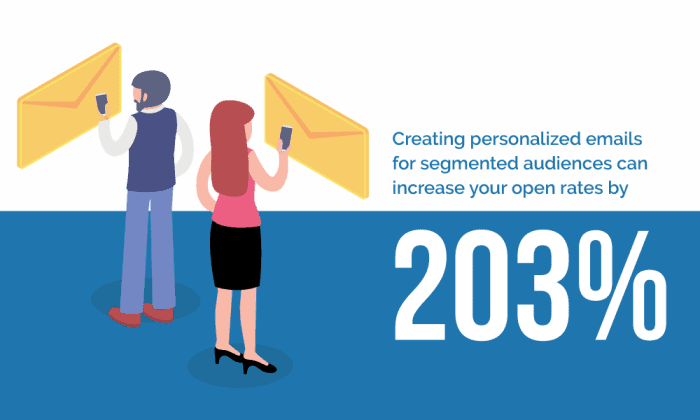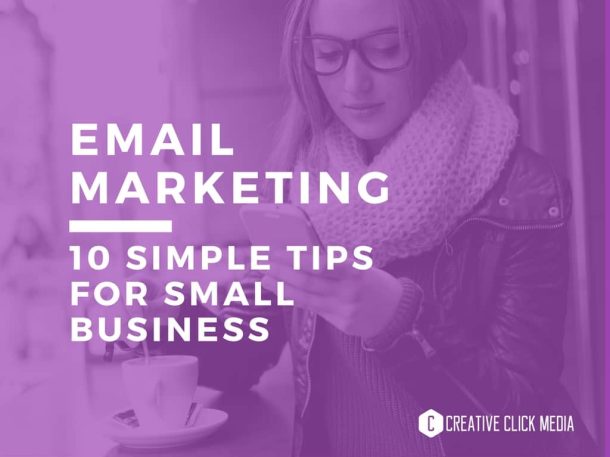A common question we hear all the time is “Are businesses even doing email marketing anymore?”
The answer is a resounding yes: email marketing is far from dead, and if it isn’t already an established part of your email marketing strategy, it should be. This very blog may have even found it’s way to you through an email – how’s that for inception?
Don’t take our word for it, let’s take a look at email marketing by the numbers:
- 99% of consumers check their emails daily
- 93% of B2B businesses are already marketing via email
- 73% of millennials prefer to communicate with businesses via email
- 59% of consumers say emails influence their buying decisions
As important as it is to use email marketing, it’s also important that you know how NOT to use email marketing. If you want the power of email marketing to work in your business’ favor, avoid these 10 email marketing mistakes.
Using “Spammy” Subject Lines
You might think including phrases like “free”, “pay less” or “cash back” will increase your open rate. In reality, they might send your email straight to the spam folder. Spam filters are intuitive and are only getting smarter as technology evolves. If your recipient has moved previous emails with similar subject lines into their spam folder, filters will eventually determine that any email using monetary language in their subject line must also be spam.
As a general rule of thumb, try to steer clear of all money-related topics in your copy – getting money, paying less money, money-back guarantees, and so on. Spam filters can also be finicky when it comes to overzealous subject lines, so stray away from phrases like “act now” and “open immediately” in addition to all-capital letters and extra exclamation points.
Not Testing Before Sending
Mistakes are an inevitable part of the human experience. Eventually you’ll make a typo on an Instagram post or forget to include a link in a blog – and that’s okay, because you can edit them afterward. When it comes to email marketing mistakes, on the other hand, once you hit send it’s gone for good, errors and all.
Make sure you test, double test and test again across devices before sending any marketing emails. Make sure everything is formatted properly, spelled correctly and is being mailed to the right recipients before hitting send. You can’t take back an email, so take the time to ensure it is perfect before it ever leaves your drafts.
 Buying or Stealing Email Lists
Buying or Stealing Email Lists
Creating an email marketing list from scratch may seem like a daunting task. This is why some companies opt to buy or steal emails in an attempt to reach their target audience. However, this is one of the worst strategies you can employ if you hope to convert new customers with your emails rather than turn them off completely.
The majority of your recipients check their email daily, if not multiple times a day. If they begin getting emails from a business they weren’t expecting, they will most likely mark it as spam – and once you’re in the spam folder, you’re not coming out. This results in a waste of your time, money and effort. It’s much more effective to build a list of genuinely interested contacts through authentic content marketing.
Not Optimizing for Mobile Inboxes
An inbox is many professionals’ lifelines, and that includes checking, reading and replying to emails on the go. With this in mind, it’s crucial that your emails are designed and optimized for mobile devices if you want to keep your content out of the trash folder.
After creating an email, send yourself a test and check its functionality from desktop to smartphone. One of the best ways to ensure your email will look and perform the same on any device is to utilize responsive design. This grid-based format will enable your design to fit any screen orientation, which will keep your business from alienating users based on the device from which they check their emails.
 Ignoring Your Analytics
Ignoring Your Analytics
Disregarding your email campaign analytics is like throwing away your map to buried treasure: If the answers you need are available to you, why guess where X marks the spot?
Your email analytics provide you with a wealth of information, such as which types of emails perform the best, which time of day generates the most opens and which audiences are the most interested in your content. This then grants you the ability to modify and optimize your emails to best suit your individual audiences, rather than wasting time and money simply guessing which emails will achieve your marketing objectives.
Sending Without a Purpose
Speaking of wasting time and money, let’s talk about purpose. If your marketing emails have no goal or objective, you might as well not be sending marketing emails at all.
Think about what you would like to achieve with every email you send: Is it selling a product? Driving traffic to a new article on your blog? Collecting customer information for a promotional giveaway? The voice and design of your emails all hinge on having an end result in mind, so be sure that every email you send is crafted purposefully in order to work towards accomplishing the goal of your overall campaign.
Emailing Too Often
One of the most common reasons users unsubscribe to a business’ emails is because they receive emails too frequently. Spamming your subscribers with an overabundance of emails is a guaranteed way to turn off your audience, potentially to the point that they tune out your business for good.
While there is no universal sweet spot for the number of emails a business should be sending per month, quality over quantity is always a winning approach. If your business is running a promotional offer, it’s okay to send daily emails during the duration of the sale as long as you slow down once it has ended. If your business is posting daily blogs, consider sending biweekly roundup emails of your most recent articles instead. That way, seeing your business’ name in their inbox will be a welcomed treat rather than a source of annoyance.
Emailing Too Infrequently
If the reaction to sending too many emails is “Them again?”, sending too few emails is bound to be met with a few “Who?”s. Although your audience may have once been eager to subscribe to your emails, weeks or even months of silence could make them forget they opted in to begin with and think your emails are spam.
Your business doesn’t need to be running a sale or launching a new product or service to have something worth emailing about. As we touched on earlier, a periodic roundup email going over everything your team has been working on lately is a great way to keep your business fresh in a subscriber’s mind and in their inbox. Even holiday greetings and check-in emails from your organization’s founder or CEO will help to connect and familiarize your audience with your brand. Strive for one or two content-packed emails per month to start, and consider increasing to weekly emails only if it makes sense for your marketing objectives.
Not Segmenting Your Audiences
Audience segmentation is an incredible tool for effective email marketing, yet it is still often underutilized by many businesses. Let’s think about the most basic way a B2B company might segment its subscribers: past clients, current clients and prospective clients. If you are promoting an offer that is only available to current clients, why risk turning off your past and prospective clients by sending them emails that are irrelevant to them?
Segmenting your audiences allows you to create personalized marketing messages that are both relevant and beneficial to a smaller group of subscribers. Think about how it might make sense to segment your audience based on the goals of your email marketing campaign, whether that be by previous shopping habits, geographical location, interests and so on. Creating personalized emails for segmented audiences can increase your open rates by 203%, so it’s worth it to break down your audiences and tailor your messaging to speak to the needs of each of your subscriber personas.
 Sending to Unengaged Contacts
Sending to Unengaged Contacts
A long subscriber list is a point of pride for many business owners, but what benefit does that serve if a portion of these subscribers never open your emails? As hard as it may be to watch your list dwindle, it might be time to cut ties with your unengaged subscribers.
Maybe your subscriber started using a new email address, or perhaps they simply aren’t interested in your business’ content any longer. No matter the case, continuing to utilize your resources on contacts who do not open your emails is a waste of company time and money. Your analytics should be able to tell you which of your subscribers have not engaged with your emails over a set period of time. Segment these subscribers into a separate list, and manually delete them if they still have not engaged six months after that. This helps to ensure you are only focusing your efforts on those users with a genuine interest in your company.
Turn Your Email Marketing Mistakes Into Successes
Email marketing can be instrumental in your business’ efforts to engage your audience, convert customers and make sales. Knowing which common email marketing mistakes to avoid will help set you up for success both in and out of your recipients’ inboxes.
Now you know which email marketing mistakes to avoid, but do you still have some burning questions about what you should be doing to achieve your email marketing goals? Reach out to our team to learn more about how to create an email marketing campaign tailored to the needs of your customers and our business.


 Buying or Stealing Email Lists
Buying or Stealing Email Lists Ignoring Your Analytics
Ignoring Your Analytics Sending to Unengaged Contacts
Sending to Unengaged Contacts


